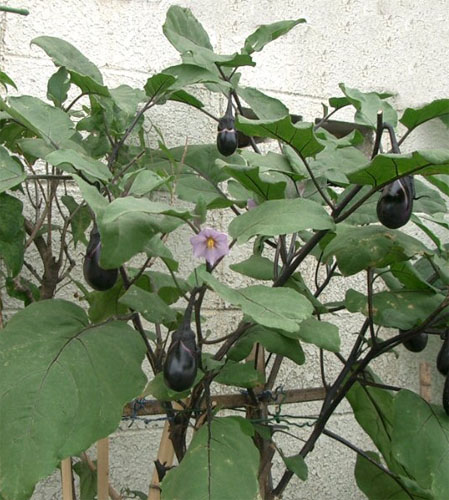 Image by Hiyo from Wikimedia Commons |
 Photograph by Mnolf in |
 Fruit of eggplant or aubergine: reproduced from Wikipedia |
 Fruit of eggplant: reproduced from Wikipedia |
 White-fruited eggplant; image by C.Ford from Brixton Market from Wikipedia |
 Line drawing by M. Szent Ivany, J. Adelaide Bot. Gard. 4 (1981) 263, fig. 116. |
 Distribution map generated from Australia's Virtual Herbarium. |

Synonymy
Solanum melongena L., Sp. Pl. 1: 186 (1753)
T: "Habitat in Asia, Africa, America." Lecto: Herb. Linn. 248.28 (LINN); microfiche AD; fide Schönbeck-Temesy in Rechinger (ed.), Fl. Iranica 100 : 70 (1972) - see the Linnaean Plant Name Typification Project.
An image of a specimen in Linnaeus's Herbarium in the Swedish Museum of Natural History (S-LINN) can be seen at http://linnaeus.nrm.se/botany/fbo/s/solan/solamel.html.en
Description
An annual herb or short-lived soft-wooded shrub to 1 m tall, cultivated for its large edible fruit; cultivated forms lack prickles (except for a few soft ones on calyx), elsewhere forms with prickles occur; all parts sparsely or densely pubescent with stellate hairs (sessile or stalked porrect-stellate), glandular hairs not obvious, aspect grey or purplish-green.
Leaves to 20cm long and 10 cm wide, ovate or ovate-oblong, entire or with 5–9 shallow sinuate lobes, lobes and sinuses rounded, base unequal, petiole 2–8 cm long.
Inflorescence a single, large, hermaphrodite flower below a short raceme of few, smaller, male flowers; in domesticated plants male flowers may be lacking on some or all inflorescences; flowers frequently multi-partite with 5–7 lobes and anthers. Hermaphrodite flower: pedicel 1.5–3 cm long, relatively stout, soon deflexed. Calyx tube 5 mm long; lobes 1–1.5 cm long, oblong-lanceolate, tapering into acumens 3–5 mm long, with a few soft prickles. Corolla 3–4 cm diam., broadly stellate. Filaments 3–4 mm long; anthers 5–7 mm long, oblong, stout, erect. Ovary pubescent at summit with stellate hairs; style 1–1.5 cm long, erect, stout; stigma terminal. Male flower: peduncle 2–4 cm long with 1–5 flowers; pedicel 1–1.5 cm long, slender. Calyx tube to 5 mm long; lobes 5–8 mm long, triangular. Corolla 3–3.5 cm diam., broadly stellate. Filaments 2–3 mm long; anthers 5–6 mm long, oblong, erect. Ovary, style and stigma vestigial or absent.
Fruiting pedicel massive, deflexed, berry 10–20 cm long, globose, obovate or oblong, glabrous, usually dark shining-purple, pale forms are known, flesh pale. Seeds 3–4 mm long, numerous, flattened, sub-reniform, pale yellow to light brown. n = 12, 18, 24 Fedorov (1969).
Distribution and ecology
Widely cultivated as a vegetable. While Asian species are referred to this species, eggplants are thought to have originated from Africa where they are referred to as S. incanum (see Relationships below).
Not known to be naturalised in Australia, but there is at least one record of its occurrence as a weed in an orchard in SA.
Common name
Egg plant, aubergine, brinjal.
Relationships
Treated as part of the S. incanum group of the subg. Leptostemonum (Whalen 1984), together with S. linnaeanum and S. marginatum. Molecular studies by T.L.Weese & L.Bohs: Eggplant origins: out of Africa, into the Orient. Taxon 59: 49-56 (2010), confirm the close relationships with S. incanum and S. linnaeanum. African eggplants are referred to S. incanum while Asian eggplants are referred to S. melongena.
Notes
No attempt will be made here to cover the horticultural aspects of this species. It is now grown as a vegetable in most of the warmer areas of the world. The fruits vary greatly in size and shape and colour. It has become popular in some home gardens to graft eggplant onto S. chrysotrichum stock to produce a perennial eggplant.
An account of eggplant domestication may be found in R.N. Lester & S.M.Z. Hasan: Origin and domestication of the Brinjal Eggplant, Solanum melongena from S. incanum, in Africa and Asia. In J. G. Hawkes et al. Solanaceae III Royal Bot. Gard. Kew (1991). A later paper, T.L.Weese & L.Bohs: Eggplant origins: out of Africa, into the Orient. Taxon 59: 49-56 (2010), uses molecular data to show eggplant origins in Africa and subsequent dispersal to the Middle East and Asia.
Because cultivated plants are often lacking the male flowers and also often lacking prickles on all but the calyx, care should be taken in keying out this species.
Selected specimens
N.S.W.: Broken Hill, 30 Jan. 1932, Morris s.n. (AD). S.A.: Cult. Tusmore, D.E. Symon 4718 (AD: 2 sheets). N.T.: Parap, 14 Oct. 1995, R. J. Horner (DNA).
From the web
Images of S. melongena can be accessed through the Vascular Plant Image Library and there are also links to a series of images on the Radboud University, Nijmegen (Netherlands) Solanaceae site.
Background information and images of eggplant can be seen at http://en.wikipedia.org/wiki/Eggplant
A comprehensive fact sheet on S. melongena in
A colour image showing a multitude of fruit types can be seen at www.plantnames.unimelb.edu.au/Sorting/DCavagnaro_Gallery.html
Limited information and links for this species can be found on the Solanaceae Source site.
Information about the genetic resources associated with eggplants can be found on Eggnet at http://www.bgard.science.ru.nl/eggnet/eggnet01.html. This site also reproduces the 1613 image of eggplant from Hortus Eystettensis.